英汉翻译教程课文4
- 格式:ppt
- 大小:166.00 KB
- 文档页数:7
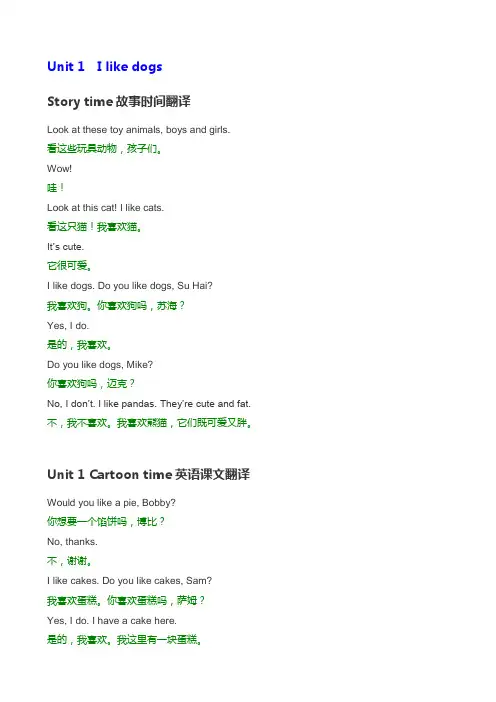
Unit 1 I like dogsStory time故事时间翻译Look at these toy animals, boys and girls.看这些玩具动物,孩子们。
Wow!哇!Look at this cat! I like cats.看这只猫!我喜欢猫。
It’s cute.它很可爱。
I like dogs. Do you like dogs, Su Hai?我喜欢狗。
你喜欢狗吗,苏海?Yes, I do.是的,我喜欢。
Do you like dogs, Mike?你喜欢狗吗,迈克?No, I don’t. I like pandas. They’re cute and fat.不,我不喜欢。
我喜欢熊猫,它们既可爱又胖。
Unit 1 Cartoon time英语课文翻译Would you like a pie, Bobby?你想要一个馅饼吗,博比?No, thanks.不,谢谢。
I like cakes. Do you like cakes, Sam?我喜欢蛋糕。
你喜欢蛋糕吗,萨姆?Yes, I do. I have a cake here.是的,我喜欢。
我这里有一块蛋糕。
Look! Do you like it?看!你喜欢它吗?Unit 1 Rhyme time英语课文翻译Little monkey小猴子Little monkey, in the tree,小猴子,在树上,Little dog, run with me!小狗,和我一起跑!Little cat, on the mat,小猫,在垫子上,Little panda, cute and fat!小熊猫,又可爱又胖!Unit 2 Let’s make a fruit salad Story time故事时间翻译I have a pineapple.我有一个菠萝。
I have a mango and an orange.我有一个芒果和一个橙子。

unit 4 American Malls 购物中心Malls are popular places for Americans to go. People like malls for many reasons. They feel safe because malls have police st ations or private美国人很喜欢去购物中心。
人们为什么喜欢购物中心,原因众多。
他们觉得购物中心里面很安全,因为有警察局或私人保安。
在购物中security guards。
Parking is usually free, and the weather inside is always fine. The newest malls have beautiful rest areas with waterfalls and large green trees.心,停车往往是免费的,而在里面气候总是很宜人。
时兴的购物中心还带有休息区域,装饰着喷泉和巨大的绿色植物。
The first indoor mall in the United States was built in 1955 in Edina, Minnesota. People love doing all their shopping in one place. More malls美国最早的室内购物中心建于1955年,位于明尼苏达州的Edina。
人们十分喜欢在购物中心里面逛个够,越来越多的购物中心出现在人are built around the country .Now, malls are like town centers where people come to do many things. They shop ,of course ,and they also eat in food们的生活中。
现在。
购物中心就像是市中心,人们在里面做各种各样的事情。

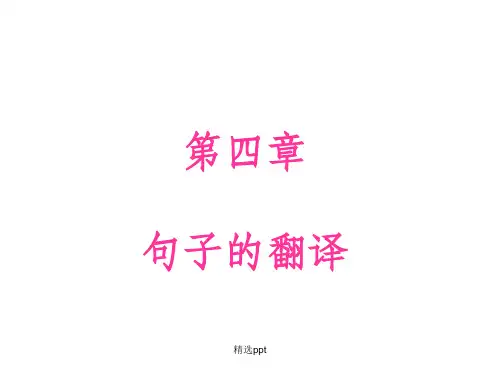
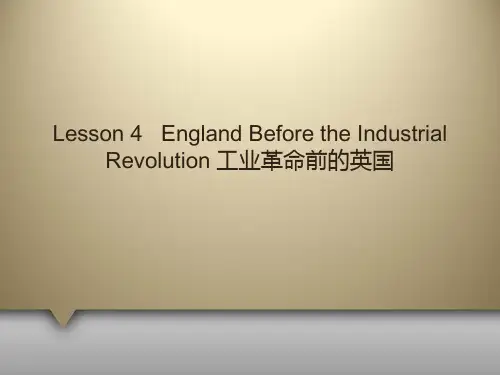
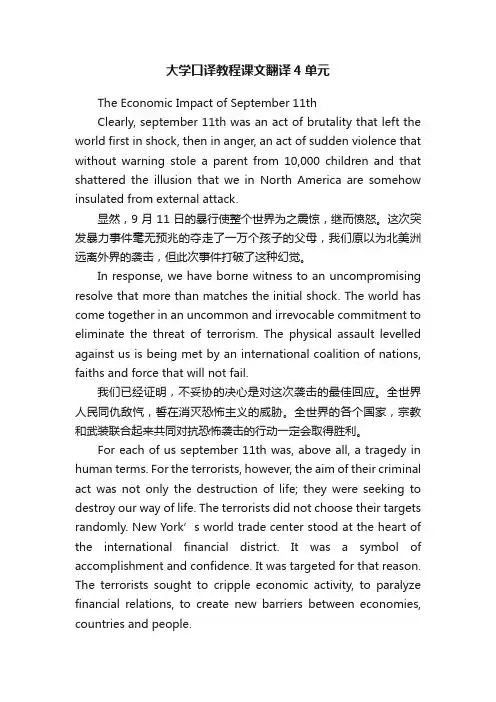
大学口译教程课文翻译4单元The Economic Impact of September 11thClearly, september 11th was an act of brutality that left the world first in shock, then in anger, an act of sudden violence that without warning stole a parent from 10,000 children and that shattered the illusion that we in North America are somehow insulated from external attack.显然,9月11日的暴行使整个世界为之震惊,继而愤怒。
这次突发暴力事件毫无预兆的夺走了一万个孩子的父母,我们原以为北美洲远离外界的袭击,但此次事件打破了这种幻觉。
In response, we have borne witness to an uncompromising resolve that more than matches the initial shock. The world has come together in an uncommon and irrevocable commitment to eliminate the threat of terrorism. The physical assault levelled against us is being met by an international coalition of nations, faiths and force that will not fail.我们已经证明,不妥协的决心是对这次袭击的最佳回应。
全世界人民同仇敌忾,誓在消灭恐怖主义的威胁。
全世界的各个国家,宗教和武装联合起来共同对抗恐怖袭击的行动一定会取得胜利。

Unit 1 I like dogsStory time故事时间翻译Look at these toy animals, boys and girls.看这些玩具动物,孩子们。
Wow!哇!Look at this cat! I like cats.看这只猫!我喜欢猫。
It’s cute.它很可爱。
I like dogs. Do you like dogs, Su Hai?我喜欢狗。
你喜欢狗吗,苏海?Yes, I do.是的,我喜欢。
Do you like dogs, Mike?你喜欢狗吗,迈克?No, I don’t. I like pandas. They’re cute and fat.不,我不喜欢。
我喜欢熊猫,它们既可爱又胖。
Unit 1 Cartoon time英语课文翻译Would you like a pie, Bobby?你想要一个馅饼吗,博比?No, thanks.不,谢谢。
I like cakes. Do you like cakes, Sam?我喜欢蛋糕。
你喜欢蛋糕吗,萨姆?Yes, I do. I have a cake here.是的,我喜欢。
我这里有一块蛋糕。
Look! Do you like it?看!你喜欢它吗?Unit 1 Rhyme time英语课文翻译Little monkey小猴子Little monkey, in the tree,小猴子,在树上,Little dog, run with me!小狗,和我一起跑!Little cat, on the mat,小猫,在垫子上,Little panda, cute and fat!小熊猫,又可爱又胖!Unit 2 Let’s make a fruit salad Story time故事时间翻译I have a pineapple.我有一个菠萝。
I have a mango and an orange.我有一个芒果和一个橙子。

纺织专业英语部分课文英汉对照翻译.doc目录01课Cotton Growing棉花种植 (1)02课Cotton Properties and Uses棉纤维的特性和用途 (2)04课Wool羊毛 (5)05课Structure and Properties of Wool羊毛纤维的结构和性能 (7)06课Silk丝绸 (10)07课Flax亚麻 (13)09课Rayon人造丝 (16)12课YARNS (19)13课纱线结构和织物外观的关系 (20)21课精纺和粗纺 (22)25课络纱 (23)27课整经 (26)33 课织机 (34)40课蓬勃发展的非织造布 (43)49课染色 (48)第一课Cotton Growing棉花种植Cotton is the world's most widely used fiber. Its popularity stems from both its relative ease of production and its applicability to a wide variety of textile products. The price of cotton yarn, however, is strongly dependent upon the cost of labor, so that in the industrialized nations, where labor is expensive, cotton yarns may be relatively high priced.棉花是世界上使用最广泛的纤维。
它的流行源于它的生产及其在纺织产品广泛适用性相对容易。
棉纱价格,然而,强烈地依赖于劳动力成本,因此,在工业化的国家,那里的劳动力昂贵,棉纱可能相对较高的价格。
Until relatively recent times, however, cotton was not as widely used as wool and linen. This was because it was easier to spin wool or flax into yam because of their greater length. In addition, cotton fibers have to be separated fromthe seeds to which they cling. This procedure was very tedious and time-consuming when done by hand. Early machinery could be used on only the longest staple cotton. So labor costs tended to be very high.直到最近,然而,棉花是没有广泛用作羊毛和亚麻布。
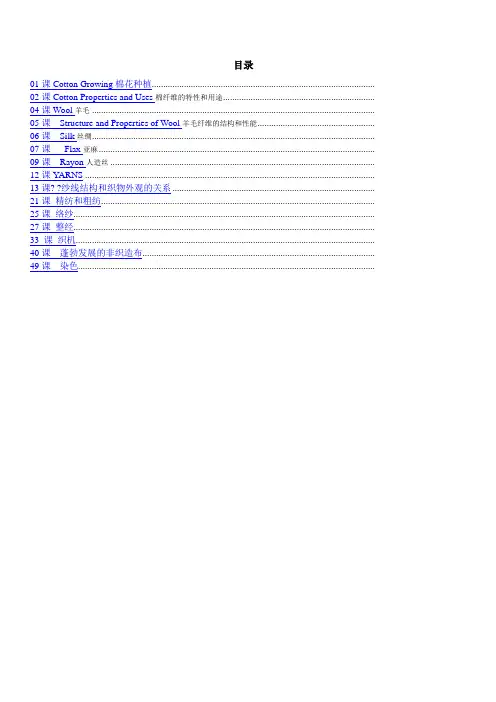
目录01课Cotton Growing棉花种植................................................................................................. 02课Cotton Properties and Uses棉纤维的特性和用途.................................................................. 04课Wool羊毛 ........................................................................................................................... 05课Structure and Properties of Wool羊毛纤维的结构和性能................................................... 06课Silk丝绸........................................................................................................................... 07课Flax亚麻........................................................................................................................ 09课Rayon人造丝 ................................................................................................................... 12课YARNS .............................................................................................................................. 13课? ?纱线结构和织物外观的关系 ........................................................................................ 21课精纺和粗纺....................................................................................................................... 25课络纱................................................................................................................................... 27课整经...................................................................................................................................33 课织机.................................................................................................................................. 40课蓬勃发展的非织造布..................................................................................................... 49课染色.................................................................................................................................第一课Cotton Growing棉花种植Cotton is the world's most widely used fiber. Its popularity stems from both its relative ease of production and its applicability to a wide variety of textile products. The price of cotton yarn, however, is strongly dependent upon the cost of labor, so that in the industrialized nations, where labor is expensive, cotton yarns may be relatively high priced.棉花是世界上使用最广泛的纤维。
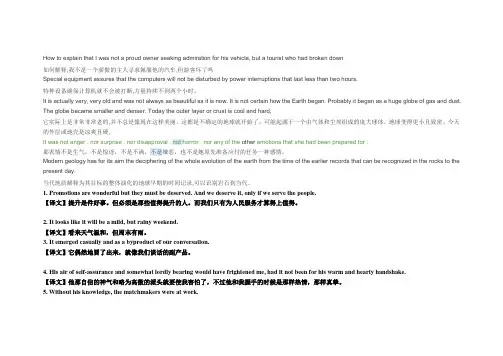
How to explain that I was not a proud owner seeking admiration for his vehicle, but a tourist who had broken down如何解释,我不是一个骄傲的主人寻求佩服他的汽车,但游客坏了吗Special equipment assures that the computers will not be disturbed by power interruptions that last less than two hours.特种设备确保计算机就不会被打断,力量持续不到两个小时。
It is actually very, very old and was not always as beautiful as it is now. It is not certain how the Earth began. Probably it began as a huge globe of gas and dust. The globe became smaller and denser. Today the outer layer or crust is cool and hard,它实际上是非常非常老的,并不总是像现在这样美丽。
这都是不确定的地球就开始了。
可能起源于一个由气体和尘埃组成的庞大球体。
地球变得更小且致密。
今天的外层或地壳是凉爽且硬,It was not anger, nor surprise, nor disapproval, not horror, nor any of the other emotions that she had been prepared for.那表情不是生气,不是惊讶,不是不满,不是嫌恶,也不是她原先准备应付的任务一种感情。
Modern geology has for its aim the deciphering of the whole evolution of the earth from the time of the earlier records that can be recognized in the rocks to the present day.当代地质解释为其目标的整体演化的地球早期的时间记录,可以识别岩石到当代。
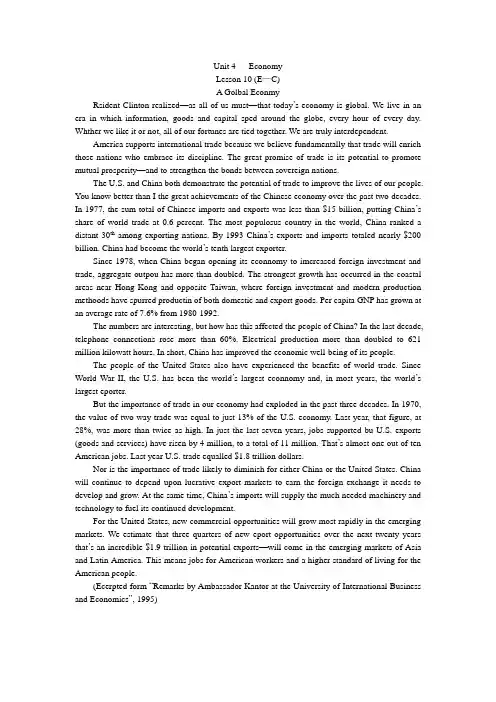
Unit 4 EconomyLesson 10 (E—C)A Golbal EconmyRsident Clinton realized—as all of us must—that today’s economy is global. We live in an era in which information, goods and capital sped around the globe, every hour of every day. Whther we like it or not, all of our fortunes are tied together. We are truly interdependent.America supports international trade because we believe fundamentally that trade will enrich those nations who embrace its discipline. The great promise of trade is its potential to promote mutual prosperity—and to strengthen the bonds between sovereign nations.The U.S. and China both demonstrate the potential of trade to improve the lives of our people. You know better than I the great achievements of the Chinese economy over the past two decades. In 1977, the sum total of Chinese imports and exports was less than $15 billion, putting China’s share of world trade at 0.6 percent. The most populosus country in the world, China ranked a distant 30th among exporting nations. By 1993 China’s exports and imports totaled nearly $200 billion. China had become the world’s tenth largest exporter.Since 1978, when China began opening its econnomy to imcreased foreign investment and trade, aggregate outpou has more than doubled. The strongest growth has occurred in the coastal areas near Hong Kong and opposite Taiwan, where foreign investment and modern production methoods have spurred productin of both domestic and export goods. Per capita GNP has grown at an average rate of 7.6% from 1980-1992.The numbers are interesting, but how has this affected the people of China? In the last decade, telephone connections rose more than 60%. Electrical production more than doubled to 621 million kilowatt hours. In short, China has improved the economic well-being of its people.The people of the United States also have experienced the benefits of world trade. Since World War II, the U.S. has been the world’s largest econnomy and, in most years, the world’s largest eporter.But the importance of trade in our economy had exploded in the past three decades. In 1970, the value of two way trade was equal to just 13% of the U.S. economy. Last year, that figure, at 28%, was more than twice as high. In just the last seven years, jobs supported bu U.S. exports (goods and services) have risen by 4 million, to a total of 11 million. That’s almost one out of ten American jobs. Last year U.S. trade equalled $1.8 trillion dollars.Nor is the importance of trade likely to diminish for either China or the United States. China will continue to depend upon lucrative export markets to earn the foreign exchange it needs to develop and grow. At the same time, China’s imports will supply the much needed machinery and technology to fuel its continued development.For the United States, new commercial opportunities will grow most rapidly in the emerging markets. We estimate that three quarters of new eport opportunities over the next twenty years that’s an incredible $1.9 trillion in potential exports—will come in the emerging markets of Asia and Latin America. This means jobs for American workers and a higher standard of living for the American people.(Ecerpted form “Remarks by Ambassador Kantor at the University of International Business and Economics”, 1995)译文:一个全球性的经济正如每个人必须认识到的那样,克林顿总统认识到当今的经济具有全球性质。
第4章Unit 4 Economy1. 经济文章选篇。
其特点是:着重说明经济形势,提出主张和建议,以大量数据说明问题。
所用语言视场合而定,文件的语言正式而精练,演讲的语言则要比较易于上口。
2. 语言对比:(1)经济术语。
经济领域有大量的专门术语。
如:two way trade双向贸易l ucrative export markets 获利的出口市场foreign exchange 外汇commercial opportunities商业机会export opportunities 出口机会potential exports潜在市场(2)有些普通词语在经济文章中有特殊含义。
经济术语有特殊的用法和搭配。
例1)The result, I believe, is that we have built the beginnings of a sound foundation for future commercial and financial ties.我相信我们已经为今后贸易与金融关系初步打下了坚实的基础。
例2)There are more than 20 joint ventures between the US and Chinese investors.现在有20多家中美合资企业。
(3)数字及有关的术语和量词。
数字很容易出错,因此要特别仔细核对。
和数字有关的动词、介词、形容词、副词也很重要。
如“增加了”和“增加”表示的意思是不一样的。
by用来表示增加或减少的幅度。
表示倍数时汉语与英语不一样。
汉语:1)甲比乙...(形容词或副词)n倍:不包括基数。
2)甲是乙n倍:包括基数。
英语:1) "n+ times + adj.比较级+than"式:包括基数;2) "n+ times + as + adj. + as"式:包括基数;3) "verb (e.g. increase, grow, rise, be raised, etc.) + n + times"式:包括基数。
Lesson 4Activity 1 RevisionTranslation of the words, phrases and sentences what we learned last time Activity 2 Nida’s theory of translation--New Attitudes withRespect to the Receptor LanguageSome of the basic difficulties in translating are caused by the wrong views people often have of the receptor and the source languages. Because of this, in order to do well in translating, translators often need to change their view of the languages in which they are working. This task aims at helping you rethink of your attitude toward your receptor language. In our case, this is of course Chinese or English.Now go through the following four passages adapted from Nida and Taber (1969) and try to summarize each one in one sentence in the space provided. Passage 1First of all, it is essential to recognize that each language has its own genius. That is to say, each language has certain distinctive characteristics, e.g., word-building capacities, unique patterns of phrase order, techniques for linking clauses into sentences, markers of discourse, and special discourse types of poetry, proverbs, and songs. Each language is also rich in vocabulary for the areas of cultural focus, e.g. cattle in Sudan, hunting and fishing in Peru, or technology in the western world.Each language has its own geniusPassage 2When translating, one must respect the features of the receptor language and exploit its potentialities to the greatest possible extent. There are some unfortunate cases where translators have actually tried to “remake” a language. For example, one missionary in Latin America insisted on introducing the passive voice of the verb into a language which had no such form. Not surprisingly, his efforts turned out to be futile. One must simply accept the fact that there are many languages which do not have a passive voice. They merely choose to report actions only as active.To communicate effectively one must respect the genius of each language. Passage 3Some translators do not see how people who have no snow can understand a passage that speaks about “white as snow”. The answer to this question is varied. Firstly, many people have a word for snow even if they have not themselves experienced it. Secondly, in other instances, people do not know snow, but they do have “frost” and they speak about the twowith the same term. Thirdly, many languages have other equivalent idioms, e.g., “white as egret(白鹭) feathers”, or “white as fungus (菌类, 蘑菇)” (if there is an especially white form of fungus). The point is that snow as an object is not crucial to the original message. Of course if the form in which a message is expressed is an essential element of the message itself, then there is a limitation in communicating the message from one language to another.Anything that can be said in one language can be said in another, unless the form is an essential element of the message.Passage 4Since all languages differ in form, quite naturally the forms must be changed if one is to preserve the content. The extent to which the forms must be changed in order to preserve the meaning depends on the linguistic and cultural distance between the source and receptor languages. The easiest transitions occur when one translates from a language such as English into German for the two are quite similar to each other both linguistically and culturally. On the other hand, if one is translating from English into Hungarian, the formal shifts will be greater, for Hungarian belongs to a different language family than English. However, Hungarian is still part of the same cultural setting as English. Hence, the shifts are not so extreme. If however, one has to translate from English into Zulu, which belongs t the so-called Bantu family of languages and represents quite a different culture, the formal modifications must be more extreme.To preserve the content of the message the form must be changed. Naturally, a new attitude towards the receptor language implies a new view of the source language as well. We don’t have to go into the great details in this respect, for there are a lot of similarities between the attitude concerning the receptor language and that concerning the source language. It suffices (vi.足够, 有能力vt.使满足) our purpose to bear in mind the following three implications with respect to the source language. (1) The source language is subject to the same limitations as any other natural language; (2) the writers of the source language expect to be understood; and (3) the translator must attempt to reproduce the meaning of a passage as understood by the writer.Activity 3 Languages Differ: Differences in Clause OrderWe have done some serious thinking about the nature of translating. Well, to be a good translator, only serious thinking is not enough. We should also practice as hard as we can and as much as we can. In this activity, we shift our attention to examining the differences in clause order between English and Chinese and the impact this has on our translating. In Chinese, we say就要毕业的学生们仍在教室里学习 while in English the same meaning is presented as Those students who were to graduate very soonwere still studying in the classroom. In the Chinese sentence, the attributive就要毕业的 is placed before 学生们 and the adverbial 在教室里 is placed before 学习, while in the English sentence, the attributive who were to graduate very soon is put after those students and the adverbial in the classroom is put after studying.Task 1 Where to Put the AttributiveQuestions:1.In Chinese, where is an attributive put?2.In English, where is an attributive put?3.Is there a difference between the word attributive and phraseattributive concerning their positions in a sentence?(Both in English and Chinese)In English, when a word is used as an attributive to modify a noun, it is usually placed before the noun, though on some rare occasions it can also be placed after noun. In Chinese an attributive is almost always put before the noun it modifies.Now translate the following phrases into Chinese, paying special attention to the positions of the attributives.1.a well-managed company 一家管理完善的公司2.the architect’s luxurious house 建筑师的豪华住宅3.the ancient Chinese philosophers 中国古代的哲学家们4.something urgent 紧急的事情5.somewhere unknown 不为人所知的某个地方Of course, not only can single words serve as attributives, but short phrases as well. In English, when a short phrase is used as an attributive to modify a noun, it is usually placed after the noun, while in Chinese it is usually put before the noun.Now translate the following items into Chinese, again paying special attention to the positions of the attributives.1.a project of building up the first corpus of spoken Chinese in China (创立中国第一个汉语口语语料库的项目)2.a student with a lot of complaints for the university(一个对学校颇多抱怨的学生)3.particles moving round their atomic nucleus(环绕原子核运动的粒子)4.a machine able to recognize human voice(能识别人的声音的机器)5.a girl wearing a long white dress(穿着白色长裙的姑娘)6.a book easy to read(一本容易读的书)Read the textbook P23-24Conclusion: Usually in English, the word attributive is put before the noun, and the phrase attributive is put after the noun, but in Chinese, it is almost always for attributives to be put before the noun.Task 2 Where to Put the Adverbial1.In Chinese, where is an adverbial put?2.In English, where is an adverbial put?3.Is there a difference between the word adverbial which modifies an adjective and the word adverbial which modifies a verb concerning their positions in a sentence?(Both in English and Chinese)Now translate the following sentences into Chinese or English, paying special attention to the positions of the adverbials.1.She was not particularly beautiful, but she certainly left a deepimpression on everybody.(她并不是特别地美丽,但她显然给每个人都留下了深刻的印象。
Unit6Text1珍珠一个城市就好象一种群栖的动物。
一个城市有神经系统,也有头,也有肩,也有脚。
一个城市也有一种整体的感情。
消息怎样在一个城市传开是一件不容易解释的神秘事情。
消息传起来,似乎比小男孩们争先恐后跑去告诉人家那样还要快,比女人们隔着篱笆喊着告诉邻居那样还要快。
在奇诺、胡安娜和别的渔民还没有来到奇诺的茅屋以前,这个城的神经系统已经随着这消息在跳动和震颤了——奇诺找到了“稀世宝珠”。
在气喘吁吁的小男孩们还来不及讲完之前,他们的母亲已经知道了。
这消息越过那些茅屋继续向前冲去,在一阵浪花飞溅的波涛中冲进那石头与灰泥的城市。
它传到正在花园里散步的神父那里,使他的眼中出现一种若有所思的神情,使他想起教堂里必须进行的一些修葺。
他不晓得那颗珍珠会值多少钱。
他也不晓得他有没有给奇诺的孩子施过洗,或者有没有给奇诺司过婚。
这消息传到开铺子的人那里,他们便看看那些销路不大好的男人衣服。
这消息传到大夫那里,他正和一个太太坐着,这女人的病就是年老,虽然她本人和大夫都不肯承认这个事实。
等他弄明白奇诺是谁以后,大夫就变得既严肃又懂事了。
“他是我的顾客,”大夫说。
“我正在给他的孩子治蝎子螫的伤。
”大夫的眼睛在它们肥胖的窝里向上翻着,他想起了巴黎。
在他回忆中,他在那里住过的屋子成了一个宏大奢华的地方,跟他同居过的面貌难看的女人成了一个又美丽又体贴的少女,尽管她完全不是那么回事。
大夫的眼光越过他那年老的病人,看到自己坐在巴黎的一家餐馆里,一个侍者正在打开一瓶酒。
这消息一早就传到教堂前面的乞丐们那里,使他们高兴得吃吃地笑了一阵,因为他们知道世界上没有比一个突然走运的穷人更大方的施舍者了。
奇诺找到了“稀世宝珠”。
在城里,在一些小铺子里,坐着那些向渔夫收买珍珠的人。
他们在椅子上坐着等待珍珠送进来,然后他们就唠叨,争吵,叫嚷,威胁,直到他们达到那渔夫肯接受的最低的价钱。
可是他们杀价也不敢超过一个限度,因为曾经有一个渔夫由于绝望,把他的珍珠送给了教会。
目录01课Cotton Growing棉花种植 (1)02课Cotton Properties and Uses棉纤维的特性和用途 (2)04课Wool羊毛 (5)05课Structure and Properties of Wool羊毛纤维的结构和性能 (7)06课Silk丝绸 (10)07课Flax亚麻 (13)09课Rayon人造丝 (16)12课YARNS (19)13课纱线结构和织物外观的关系 (20)21课精纺和粗纺 (22)25课络纱 (23)27课整经 (26)33 课织机 (34)40课蓬勃发展的非织造布 (43)49课染色 (48)第一课Cotton Growing棉花种植 Cotton is the world's most widely used fiber. Its popularity stems from both its relative ease of production and its applicability to a wide variety of textile products. The price of cotton yarn, however, is strongly dependent upon the cost of labor, so that in the industrialized nations, where labor is expensive, cotton yarns may be relatively high priced.棉花是世界上使用最广泛的纤维。
它的流行源于它的生产及其在纺织产品广泛适用性相对容易。
棉纱价格,然而,强烈地依赖于劳动力成本,因此,在工业化的国家,那里的劳动力昂贵,棉纱可能相对较高的价格。
Until relatively recent times, however, cotton was not as widely used as wool and linen. This was because it was easier to spin wool or flax into yam because of their greater length. In addition, cotton fibers have to be separated from the seeds to which they cling. This procedure was very tedious and time-consuming when done by hand. Early machinery could be used on only the longest staple cotton. So labor costs tended to be very high.直到最近,然而,棉花是没有广泛用作羊毛和亚麻布。
UNIT41. Think for a moment about your own life — the activities of your day, the possessions you enjoy, the surroundings in which you live. Is there anything you don’t have at this moment that you would like to have? Anything that you have, but that you would like more of? If your answer is “no,” then congratulations — either you are well advanced on the path of Zen self-denial, or else you are a close relative of Ted Turner . The rest of us, however, would benefit from an increase in our material standard of living. This simple truth is at the very core of economics. It can be restated this way: we all face the problem of scarcity.2 Almost everything in your daily life is scarce. You would benefit from a larger room or apartment, so you have a scarcity of space. You have only two pairs of shoes and could use a third for hiking; you have a scarcity of shoes. You would love to take a trip to Chicago, but it is difficult for you to find the time or the money to go — trips to Chicago are scarce.3 Because of scarcity, each of us is forced to make choices. We must allocate our scarce time to different activities: work, play, education, sleep, shopping, and more. We must allocate our scarce spending power among different goods and services: food, furniture, movies, long-distance phone calls, and many others.4 Economists study the choices we make as individuals and how those choices shape our economy. For example, the goods that each of us decides to buy ultimately determine which goods business firms will produce. This, in turn, explains which firms and industries will hire new workers and which will lay them off.5. Economists also study the more subtle and indirect effects of individual choice on our society. Will most Americans continue to live in houses, or — like Europeans will most of us end up in apartments? Will we have an educated and well-informed citizenry? Will museums and libraries be forced to close down? Will traffic congestion in our cities continue to worsen, or is there relief in sight? These questions hinge, in large part, on the separate decisions of millions of people. To answer them requires an understanding of how people make choices under conditions of scarcity.6. Think for a moment about the goals of our society. We want a high standard of living for all citizens: clean air, safe streets, and good schools. What is holding us back from accomplishing all of these goals in a way that would satisfy everyone? You probably already know the answer: scarcity. 1. 想一想你的生活:你每天从事的活动,你所拥有的财产,你所居住的环境。